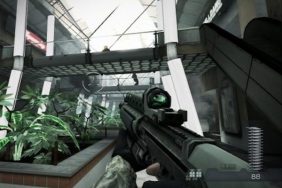For years it felt as though the singular, utmost concern of video game-dom was to be acknowledged as art. It happened gradually, and there are still occasional loops and tangles to iron out, but by and large gaming’s artistic value has, at long last, been substantiated. Blockbusters like Grand Theft Auto now come standard with affecting, true-to-life fictive accounts, while fringe players such as Zero Escape stalk the outskirts of common convention, toting layered characters who shatter the fourth wall with the simple flick of a non-sequential, two-headed Trömner. Beyond: Two Souls features Hollywood talent, Mario hangs out at the Smithsonian, and Journey brings us places that can only be described as wholly spiritual. So what now? Well, now is the time for our newborn artform — like film and literature before it — to refract in a thousand different directions. This is where players choose their own path, and track down gaming’s quirks and hidden gems for themselves. In other words, titles like Child of Light begin popping up, and it’s our civic duty as gamers to appreciate them.
It’s immediately clear that Child of Light amounts to more than the sum of its parts, and the weight of one part in particular goes a long way in defining the game’s brilliant audiovisual presentation. Child of Light isn’t just art, but rather a literal work of art — its lost world of Lemuria is without a doubt the most lush and fetchingly occulted digital space I’ve explored this year. I love the Rayman games, but I’d always wondered what the UbiArt Framework might be capable of if applied to a more serious premise, in a more enchanting world. Child of Light is that game, and the wondrous bliss of traversing Lemuria’s hand-drawn terrene, in search of celestial bodies that will save its dying world, is the game’s biggest selling point.

The strength of Child of Light’s aesthetic almost places other pros in “icing on the cake” territory, and I was quite pleased by just how much icing I came across. Most notably, the game is far more of an RPG than you think it is; in fact, if you’ve only casually watched gameplay videos or trailers, you may not have known of its RPG qualities at all. Coming into contact with an enemy while platforming sends you straight to battle mode, complete with dedicated musical themes and turn-based RPG combat. Amidst the overload of imaginative eye-candy, some familiarity was, at least for me, extremely welcome.
Even so, Child of Light does a nice job injecting its combat with a compelling gimmick, one that requires strategy while retaining relative simplicity. Essentially, it’s a timed system — you can take as long as you’d like selecting spells or items when it’s your turn, but between actions the onscreen events flow in what cleverly feels like real time. You can control your firefly companion with the right analog stick, distracting enemies and slowing their movement on the timeline, but this is a finite resource. Use it too much, and you’ll be powerless to counter enemy buffs or time your attacks the way you want to. It can get hectic and laugh-out-loud funny at times, with characters and enemies whizzing past each other on the timeline at breakneck speed. The system is hardly groundbreaking, but it is unique and fun, and battle never feels like a chore.
There is another combat layer I ought to mention:interruption. If you hit an enemy during the time it takes to cast or wind up an attack, it will be interrupted, and unable to harm you until the next cycle. This goes both ways, though Aurora and her companions (yes, you have party members!) can go on the defensive or utilize tactics to avoid it being too much of a problem. It sounds a bit confusing, but it’s really not. Child of Light’s combat strikes a great balance between strategy, timing, and simplicity, a complicated trinity that developers rarely bother with fully, more often opting for two of the three. Ubisoft Montreal deserves a pat on the back here. Good job, guys and gals.
There are other role-playing systems thrown into mix, such as leveling up, skill trees, and elemental type advantages, but even then I’d imagine certain RPG junkies might find the offering a bit lacking. If you cut your teeth on Bravely Default, or enjoy reading the endless text tutorials of Conception II, then Child of Light may seem a bit RPG-lite to you. That said, I’d bet the average player will find that its RPG trimmings blend wonderfully with the platforming, puzzling, and otherworldly exploration offered by the rest of the game. There’s even a fairly robust jewel-crafting system. You can take it or leave it, but it’s there.
Child of Light’s only real flaw is a minor case of do-it-all-ism. If you expect combat to rival Fire Emblem, or platforming to trump Rayman, then you’re going to be disappointed. Still, Lemuria has something those games don’t: a divine, inspired sense of beauty. Simply moving through the world is breathtaking, and in conjunction with an excellent soundtrack, the sublimity of it all is more than worth the asking price. Throw in some wonderful character abilities that I won’t spoil here, and Child of Light is a rare game that lets you feel like a child yourself, in the best possible way. Cheers to you, Ubisoft. Games as art, indeed.

Griffin Vacheron is a Writer for CraveOnline. You can follow him on Twitter @novacav.
PS3 copy provided by publisher. Game is available on PC, PS3, PS4, Xbox One, Xbox 360, and Wii U.








